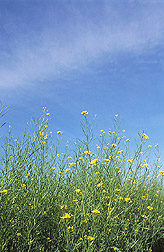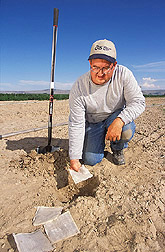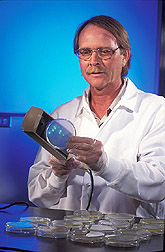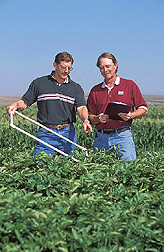|
|
|
Display category headings
| |
Mustard for Pest Control, Not for Your Sandwich
|

A cover crop of mustard like
the one shown above can be
disked into soil as "green
manure" to act as a natural
fumigant for weeds and
diseases.
(K11449-1) |
Got nematode troubles? Fungi? Too many weeds in a field? Spread some
mustard on 'em.
Agricultural Research Service
and university scientists are experimenting with mustards as an alternative
to chemically fighting crop pests.
But scientists aren't smearing pests with mustard that comes in a jar.
Rather, they're biofumigating pests with stands of white mustard, brown
mustard, and rapeseed—members of the Brassica plant family.
"Biofumigation" refers to natural substances plants release
while decomposing that make surrounding soils toxic to some weeds, nematodes,
and fungi.
The experiments, in Washington State, dovetail with increasing grower
interest in mustard crops for pest control and as "green manure"—meaning
it can be disked into soil to improve tilth, organic matter, aeration,
and water filtration.
Despite such benefits, there's still much to learn about how mustards
control pests and under what conditions they work best, notes ARS agronomist
Rick Boydston, study coordinator since 2000.
|

In autumn, technician Dallas
Spellman buries nylon packets
containing weed seeds to
evaluate their survival
with various fall-planted
cover crops.
(K11452-1) |
Much credit for mustard's biofumigant effect against soilborne pests
is given to isothiocyanates (ITCs), chemical byproducts of the plants'
decomposition. But scientists suspect ITCs are only one piece of the
pest-control puzzle.
"There's a lot going on there that we don't know about,"
says Boydston, at ARS's Vegetable and Forage Research Unit, Prosser,
Washington. A chief question is whether nematodes, weed seeds, or fungi
die from direct contact with ITCs or as a result of other chemical or
biological changes in soil.
To find out, Boydston is collaborating with the multidisciplinary team
of Ashok Alva, a soil scientist who leads the Prosser lab; Harold Collins,
an ARS microbiologist there; Steve Vaughan, a chemist at ARS's National
Center for Agricultural Utilization Research, Peoria, Illinois; Ekaterini
Riga, a nematologist at Washington State University (WSU) in Prosser;
and Andy McGuire, an agricultural systems educator with WSU's Center
for Sustaining Agriculture and Natural Resources, in Ephrata.
With such wide-ranging expertise, the team can examine many facets
of mustard cover crops that growers have neither the time nor resources
for.
|

Microbiologist Harold Collins
evaluates soil bacterial diversity
under various cover crop treatments.
(K11451-1) |
"Growers are probably more focused on nematode suppression and
wind erosion control. But our group can measure disease incidence, nematodes,
weeds, and soil microorganisms," he says. "We're looking at
multiple problems and benefits."
The resulting information could lead to new cropping systems that use
mustards better—or pinpoint their limitations. Another possible
spinoff could be development of new mustard cultivars custom-bred for
specific uses, such as anchoring soil or biofumigating it.
The following experiments are under way at several Washington locations:
- Weed-seed bank: In this study, small nylon bags were filled
with 500 redroot pigweed seeds and buried at 1 or 8 inches deep. The
plots were then overseeded with white mustard, sorghum-sudangrass,
winter wheat, or a mix of oat and hairy vetch. Other plots, left fallow,
were either fumigated with metam sodium and 1,3-dichloropropene or
were not treated.
In spring, sacks were dug up and the seeds removed and replanted to
see whether they'd germinate. "If the seed doesn't sprout, this
suggests presence of toxins, such as ITCs, from the cover crop we
used," explains Boydston. Citing 2003 results, he adds, "We're
not seeing a big effect on buried seed, though we do see a delay in
germination." By comparison, 99 percent of seed from fumigated
plots didn't sprout.
|

Agronomist Rick Boydston and
microbiologist Harold Collins
record weed density in potatoes
after cover crop treatments.
(K11450-1) |
- Mustard mulching: This Prosser greenhouse study pits three
biofumigant crops (white mustard, brown mustard, and rapeseed) against
small-seeded weeds—redroot pigweed and barnyard grass. When mixed
into soil, the three mulches cut weed germination by 20 percent to
95 percent. Reductions of 5 percent to 95 percent in growth of seedlings
from surviving seeds were also observed.
- Potted ornamentals: This greenhouse study evaluated the biofumigant
effects of crushed seed meal from brown mustard and field pennycress.
The targeted pests were chickweed, prickly lettuce, and root-knot
nematode.
First, scientists mixed the seed meal at 0.2 percent to 0.4 percent
by weight into potting soil and then planted irises. They then added
100 chickweed seeds, 100 prickly lettuce seeds, and 400 nematodes.
As a chemical control, other pots were sprayed with the nematicide
ethoprop. At 2, 4, and 6 weeks, they checked the pots for diminished
seed germination and sprouting. Nematodes were extracted and counted
at the experiment's end.
In pennycress-treated pots, about 80 percent fewer chickweed seeds
and 55 percent fewer prickly lettuce seeds sprouted. Brown mustard
seed meal reduced chickweed emergence by 65 percent and prickly
lettuce by half. The irises were unaffected. Early results revealed
a 70 percent to 80 percent nematode decline in pots containing the
seed meals. The scientists are now testing higher seed-meal concentrations
and expect to see even fewer nematodes.
- Crop rotation: Since 2000, the researchers have preceded
potato or sweet corn crops with fall-planted cover crops of mustard,
winter wheat, sorghum-sudangrass, or oat plus hairy vetch. Another
plot, left fallow, is fumigated for comparison. "We have a 4-year
rotation in place and are using these covers in 3 of the 4 years,"
says Boydston. "We hope to detect any cumulative effects of the
cover crop's continued use." Throughout, the scientists are monitoring
the covers' effects on weed emergence, seedling growth, species distribution,
and density.
- Biomass: Using mustards costs about $90 per acre, notes McGuire.
Growers can generally recoup by rotating mustard with a high-return
crop like potato. To help them get the most bang for their buck, the
researchers are studying the best mustard-seeding time for producing
the most biomass, which is thought to be important for many of the
crop's benefits.
They also want to determine the best time to disk mustard into the
soil to unleash its biofumigants. Current thinking is that disking live,
green mustard will trigger the greatest release of glucosinolates, which
break down into ITCs. But other compounds or soil factors may contribute
as much as or more than ITCs to suppressing weeds and diseases. To find
out, researchers are comparing weed densities after mustard is disked
into the soil in fall while it is still alive and in spring after it
has died.
In still other studies, Collins is looking at how microbial soil communities
may change in response to mustards and their decomposition. He and Alva
are also using isotopes of nitrogen to trace how much of this nutrient
mustard returns to soil for other crops to use.
McGuire evaluates various mustard cultivars, including some from Italy
and Germany, for their ease of growth, flowering times, biomass, and
glucosinolates. Meanwhile, WSU colleague James Dobrowolski is testing
wind-erosion resistance of mustard-amended soil by blasting it with
gusts from a wind machine.—By Jan
Suszkiw, Agricultural Research Service Information Staff.
This research is part of Integrated Farming Systems, an ARS National
Program (#207) described on the World Wide Web at www.nps.ars.usda.gov.
Ashok Alva, Rick
A. Boydston, and Harold
Collins are in the USDA-ARS Vegetable
and Forage Crop Research Unit, 24106 N. Bunn Rd., Prosser, WA 99350;
phone (509) 786-9228, fax (509) 786-9277.
"Mustard for Pest Control, Not for Your Sandwich"
was published in the October
2004 issue of Agricultural Research magazine.
|
[Top]
|
|
|